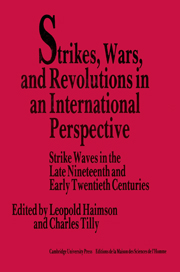 Strikes, Wars, and Revolutions in an International Perspective
Strikes, Wars, and Revolutions in an International Perspective Published online by Cambridge University Press: 25 March 2010
Analyzing the impact of 1917 on strikes in Russia is something like retrieving spilled mercury. Revolutionary change created such fluid circumstances that strikes and protests often changed their nature in the very course of occurring; and just as one is about to get an analytical grasp on events, their form shifts and they skitter from reach, changing size and shape even as they continue to remain the same elemental material.
Changes in Russia's political environment altered the meaning of strikes from the first. Largely illegal and hence explicitly political before the overthrow of the tsar, strikes in 1917 simultaneously became a “routine” element of democratic labor–management conflict and an implicit challenge to the ability of both soviet and government leaders to develop stable social relations and workable democratic institutions. As in other areas of life in 1917, the exercise of democratic rights weakened democratic structures, a paradox of political transformation common to most revolutionary situations. Thus, strikes in the spring, which had as their goal the consolidation of revolutionary gains through improving material welfare and eliminating arbitrary and authoritarian social relations in the workplace, became in the fall a central aspect of social polarization and the breakdown of democratic order, and an important social basis for the Bolsheviks' coming to power.
The same can be said about Russia's economic circumstances and the rapidly changing conditions of work that led in a brief time to fundamental changes in patterns of industrial management and management–worker relations.
To save this book to your Kindle, first ensure [email protected] is added to your Approved Personal Document E-mail List under your Personal Document Settings on the Manage Your Content and Devices page of your Amazon account. Then enter the ‘name’ part of your Kindle email address below. Find out more about saving to your Kindle.
Note you can select to save to either the @free.kindle.com or @kindle.com variations. ‘@free.kindle.com’ emails are free but can only be saved to your device when it is connected to wi-fi. ‘@kindle.com’ emails can be delivered even when you are not connected to wi-fi, but note that service fees apply.
Find out more about the Kindle Personal Document Service.
To save content items to your account, please confirm that you agree to abide by our usage policies. If this is the first time you use this feature, you will be asked to authorise Cambridge Core to connect with your account. Find out more about saving content to Dropbox.
To save content items to your account, please confirm that you agree to abide by our usage policies. If this is the first time you use this feature, you will be asked to authorise Cambridge Core to connect with your account. Find out more about saving content to Google Drive.